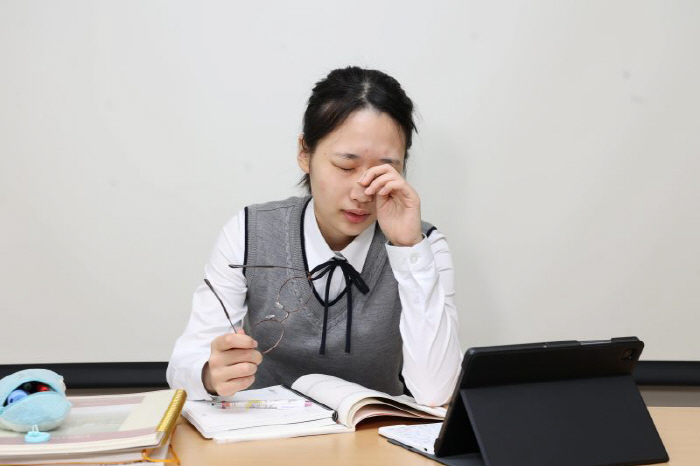College Scholastic Ability Test D9: How to protect the eye health of test takers
Nov 04, 2025
The 2026 College Scholastic Ability Test is on the horizon. Students, including test takers who prepare for the exam for a long time, need to pay attention to eye health because they use books or electronic devices for a long time.
As many students use electronic devices such as smartphones and tablets not only for their leisure time but also for studying, the overall amount of time spent on electronic devices is increasing. In fact, according to the results of a survey on the use of teen media conducted by the Korea Press Promotion Foundation in 2022, Internet usage time was about 8 hours a day, an increase of 1.8 times compared to 2019.
If you focus on books or electronic devices with dense letters for a long time, the number of times you blink can decrease and the surface of your eye becomes dry, causing dry eyes or worsening. If the symptoms worsen, stiffness, damage to the eyeball surface, and severe foreign body sensations can occur. In addition, during such short-range work, the control muscles that control the thickness of the lens inside the eye continue to contract, and at this time, the eye may continue to be concentrated and eye fatigue may increase. In particular, reading a book on a shaky bus or subway should be careful because your eyes can easily get tired because your eyes continue to focus on the retina.
In many cases, people only turn on the stand at night or rely on the light of a monitor or tablet screen to take Internet lectures, but exposure to too strong light in a dark environment can strain their eyes. When studying in such an environment, the pupil becomes large, and if you have astigmatism, light passing through the irregular surface of the cornea with the enlarged pupil enters the eye, and symptoms of two objects may appear.
If you have strabismus, long-term study can lead to heavy eye fatigue and dazed pain around the eyes, and test takers with intermittent exotropia may complain of sudden splitting of the image.
In order to protect eye health, it is necessary to guide the right learning environment around you so that you can live in the right posture and minimize eye fatigue.
When sitting at a desk, it is recommended to keep a distance of at least 30 cm from books or electronic devices. It is recommended not to use it for a long time, but if it is unavoidable to use it for a long time, it is recommended to rest your eyes by looking at the distance for 10 minutes every 50 minutes.
It is desirable to avoid the habit of studying with only a stand on in a dark environment and maintain an appropriate illuminance. The brightness of light that the eyes feel comfortable with is about using one incandescent light and one stand fluorescent light. If you have symptoms such as eye pain, double vision, or blurred objects while studying, it may be a sign of eye disease, so it is better to visit an ophthalmologist for a checkup.
Kim Dae-hee, a specialist at Sashi & Pediatric Ophthalmology Center at Kim Ophthalmology Hospital, said, `Takers can easily get tired and dry eyes because they spend most of the day studying by reading books or using electronic devices"It is important to take proper rest and manage healthy eyes to use them for a long time through lifestyle practices that help with eye health."
As many students use electronic devices such as smartphones and tablets not only for their leisure time but also for studying, the overall amount of time spent on electronic devices is increasing. In fact, according to the results of a survey on the use of teen media conducted by the Korea Press Promotion Foundation in 2022, Internet usage time was about 8 hours a day, an increase of 1.8 times compared to 2019.
If you focus on books or electronic devices with dense letters for a long time, the number of times you blink can decrease and the surface of your eye becomes dry, causing dry eyes or worsening. If the symptoms worsen, stiffness, damage to the eyeball surface, and severe foreign body sensations can occur. In addition, during such short-range work, the control muscles that control the thickness of the lens inside the eye continue to contract, and at this time, the eye may continue to be concentrated and eye fatigue may increase. In particular, reading a book on a shaky bus or subway should be careful because your eyes can easily get tired because your eyes continue to focus on the retina.
In many cases, people only turn on the stand at night or rely on the light of a monitor or tablet screen to take Internet lectures, but exposure to too strong light in a dark environment can strain their eyes. When studying in such an environment, the pupil becomes large, and if you have astigmatism, light passing through the irregular surface of the cornea with the enlarged pupil enters the eye, and symptoms of two objects may appear.
If you have strabismus, long-term study can lead to heavy eye fatigue and dazed pain around the eyes, and test takers with intermittent exotropia may complain of sudden splitting of the image.
In order to protect eye health, it is necessary to guide the right learning environment around you so that you can live in the right posture and minimize eye fatigue.
When sitting at a desk, it is recommended to keep a distance of at least 30 cm from books or electronic devices. It is recommended not to use it for a long time, but if it is unavoidable to use it for a long time, it is recommended to rest your eyes by looking at the distance for 10 minutes every 50 minutes.
It is desirable to avoid the habit of studying with only a stand on in a dark environment and maintain an appropriate illuminance. The brightness of light that the eyes feel comfortable with is about using one incandescent light and one stand fluorescent light. If you have symptoms such as eye pain, double vision, or blurred objects while studying, it may be a sign of eye disease, so it is better to visit an ophthalmologist for a checkup.
Kim Dae-hee, a specialist at Sashi & Pediatric Ophthalmology Center at Kim Ophthalmology Hospital, said, `Takers can easily get tired and dry eyes because they spend most of the day studying by reading books or using electronic devices"It is important to take proper rest and manage healthy eyes to use them for a long time through lifestyle practices that help with eye health."
|
This article was translated by Naver AI translator.














